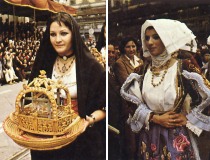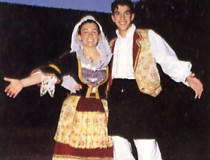Sardinian Customs
Sardinian traditions |  |
 CUSTOMS - Sardinia is a land rich in story and traditions. Besides its natural
beauties, that make it well-known all over the world, it has numerous
folkloristic aspects with ancient roots. Among the insular customs one of
the most typical elements is surely the variety of local customs, different
from village to village. The Sardinian traditions are particularly
elaborated and multicolored.
CUSTOMS - Sardinia is a land rich in story and traditions. Besides its natural
beauties, that make it well-known all over the world, it has numerous
folkloristic aspects with ancient roots. Among the insular customs one of
the most typical elements is surely the variety of local customs, different
from village to village. The Sardinian traditions are particularly
elaborated and multicolored.
|
 Local dresses and traditions represent a piece of Sardinian history because
they derive from the Roman, eastern, Hispanic-Saracen influence and
therefore they are symbols of the most different civilizations that
alternated in the control of the region; this is the main reason for the
heterogenic Sardinian traditions, above all of the feminine ones, which let
us retrace the long history till today.
Local dresses and traditions represent a piece of Sardinian history because
they derive from the Roman, eastern, Hispanic-Saracen influence and
therefore they are symbols of the most different civilizations that
alternated in the control of the region; this is the main reason for the
heterogenic Sardinian traditions, above all of the feminine ones, which let
us retrace the long history till today.
|
 DECORATIONS - Sardinian decorations are harmonized to the clothing and
contribute to give it a greatest result: gold and silver buttons, rings,
bracelets, necklaces, chains, dangles, amulets and clocks, taps, buckles;
decorations are often realized in watermark and already in the past they
agve a considerable impulse to local craftsmanship that still today is
rather renowned: the goldsmith tradition is alive in several centres of the
island where jewellery is still engraved to chisel and patiently beaten by
hand with a hammer. A place of relief deserve the intense activities
realized in coral, the red Sardinian gold, retained by the experts one of
the best coral in the world.
DECORATIONS - Sardinian decorations are harmonized to the clothing and
contribute to give it a greatest result: gold and silver buttons, rings,
bracelets, necklaces, chains, dangles, amulets and clocks, taps, buckles;
decorations are often realized in watermark and already in the past they
agve a considerable impulse to local craftsmanship that still today is
rather renowned: the goldsmith tradition is alive in several centres of the
island where jewellery is still engraved to chisel and patiently beaten by
hand with a hammer. A place of relief deserve the intense activities
realized in coral, the red Sardinian gold, retained by the experts one of
the best coral in the world.
|
 MASCULINE AND FEMININE DRESS - The typical elements of the masculine custom
are the cap, the shirt, the gilet, the jacket, the "ragas", the white pants
of linen, the coat, the characteristic "gabbanu" - typical of the pastoral
tradition and the mastruca, a big skin capsize of sheep with wool. Besides
we often find the "collettu": a coat of leather that arrives at the knee,
opened in front and held by a belt of leather.
MASCULINE AND FEMININE DRESS - The typical elements of the masculine custom
are the cap, the shirt, the gilet, the jacket, the "ragas", the white pants
of linen, the coat, the characteristic "gabbanu" - typical of the pastoral
tradition and the mastruca, a big skin capsize of sheep with wool. Besides
we often find the "collettu": a coat of leather that arrives at the knee,
opened in front and held by a belt of leather.
|
|
|
|
|

